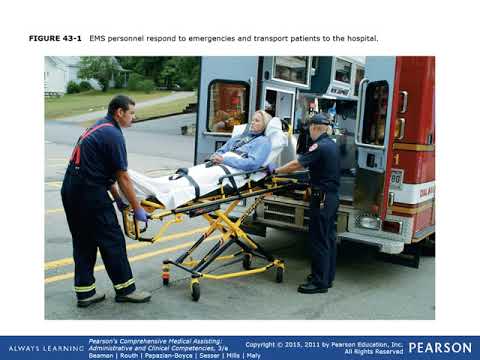What is the Job of a Medical Assistant?
Contents
A medical assistant is a vital member of any healthcare team. They perform a variety of administrative and clinical tasks to keep the office running smoothly. If you’re thinking of becoming a medical assistant read on to learn more about the job and what it entails.
Checkout this video:
Job Description
A medical assistant is a multi-skilled professional who performspredominantly clerical duties in doctors’ offices, clinics and other ambulatory health care facilities. They are also responsible for basic patient care and may take vital signs, administer injections, prepare patients for examinations and perform minor office surgical procedures.
Duties and Responsibilities
A medical assistant is a multi-skilled health professional that supports the work of physicians and other health professionals, usually in an outpatient setting. Medical assistants perform a variety of administrative and clinical tasks to keep the offices of physicians and other health practitioners running smoothly. The duties and responsibilities of Medical Assistants vary from state to state and from one medical practice to another. Here are some examples of what medical assistants may do on a daily basis:
Front office duties:
Answer telephones
Schedule appointments
Greet patients
Fill out insurance forms
Code and process patient billing information
Clinical duties:
Measure patients’ vital signs, such as height, weight, blood pressure, pulse, and temperature
Explain treatment procedures to patients
Prepare patients for examination
Assist the physician during examinations
Collect urine and blood samples for laboratory testing
Perform basic laboratory tests
Give injections as directed by a physician
Schedule diagnostic tests, such as X-rays, MRIs, and CAT scans
State law generally requires that medical assistants be certified or registered in order to perform certain tasks, such as taking X-rays or giving injections. Employers may require certification as well. A number of certification programs are available for medical assistants.
Skills and Qualifications
Skills and qualifications for medical assistants vary by employer. However, certain skills and traits are necessary for all medical assistants, such as:
-Compassion: One of the most important qualities a medical assistant can possess is compassion. This quality allows them to empathize with patients and show concern for their well-being.
-Communication skills: Medical assistants must be able to effectively communicate with patients, doctors, and other members of the healthcare team. They also need to be able to understand and follow instructions.
-Attention to detail: Medical assistants must be detail oriented in order to accurately record patient information and perform tasks such as taking vital signs.
-Organizational skills: Medical assistants must be able to effectively organize their work in order to complete tasks in a timely manner. This includes keeping track of patient records and scheduling appointments.
-Interpersonal skills: Medical assistants must be able to build rapport with patients and work well with other members of the healthcare team.
Education and Training
Education and Training Requirements
There are no formal education requirements to become a medical assistant, but most medical assistants have at least a high school diploma. Many employers prefer to hire candidates who have completed a postsecondary educational program in medical assisting. These programs typically last one year and result in a certificate or diploma. Some programs take longer and result in an associate degree. A small number of programs offer a medical assistant bachelor’s degree, but this is not the norm.
Salary and Job Outlook
Medical assistants are versatile and are able to perform many tasks in a medical facility. They can work in a number of settings, including doctor’s offices, hospitals, and clinics. The job outlook for medical assistants is positive, with an expected growth of 29 percent from 2016 to 2026, much faster than the average for all occupations. The median salary for medical assistants was $31,540 in 2017.
Certification and Licensure
There are no formal education requirements for medical assistants, but most have at least a high school diploma, and many have completed a postsecondary education program. Employers prefer to hire candidates who have completed a formal training program in medical assisting. These programs typically last 1 year and lead to a certificate or diploma. Some community colleges offer 2-year programs that lead to an associate’s degree in medical assisting.
Most states do not require medical assistants to be licensed or certified, but some employers prefer or require certification. Certification shows that a medical assistant meets certain standards of competency and knowledge. The two main certifying organizations for medical assistants are the American Association of Medical Assistants (AAMA) and the National Healthcare Association (NHA). To be eligible for certification, candidates must graduate from an accredited program and pass a certification exam. Those who are certified must renew their credential every 60 months by completing continuing education requirements or re-taking the exam.
Advancement Opportunities
When it comes to job satisfaction, medical assistants rate their profession highly. In fact, the majority of medical assistants are happy in their jobs and would recommend the profession to others, according to a survey by the American Association of Medical Assistants.
One of the reasons medical assistants report high job satisfaction is because they have opportunities to advance in their careers. With additional training and experience, medical assistants can move into supervisory roles or take on more responsibility in areas such as billing and insurance coding. Some medical assistants even go on to become registered nurses or physician’s assistants.
Working Conditions
Medical assistants work in a variety of healthcare settings, including doctors’ offices, hospitals, and clinics. They usually work full time, although some may work part time. Many medical assistants have flexible schedules that allow them to work evenings or weekends. Some medical assistants may be required to work overnight shifts in hospital settings.
Job Hazards
Medical assistants are allied health professionals who perform a variety of administrative, clerical and clinical tasks in physician offices, hospitals and other healthcare facilities. They are a vital part of the healthcare team and can perform many different job duties, depending on their employer’s needs.
While medical assisting is generally a safe occupation, there are some job hazards that workers should be aware of. These include exposure to infections and communicable diseases, needlesticks, back injuries from lifting patients and emotional stress.
Medical assistants can minimize their risk of injury by following safety protocols, using proper body mechanics when lifting patients and taking breaks to reduce stress.
Employment Opportunities
Medical assistants are in demand in a variety of employment settings, including:
-Hospitals
-Clinics
-Physicians’ offices
-Insurance companies
-Nursing homes
-Public health agencies
-Community health centers






